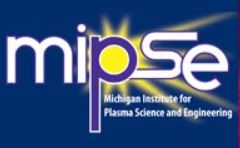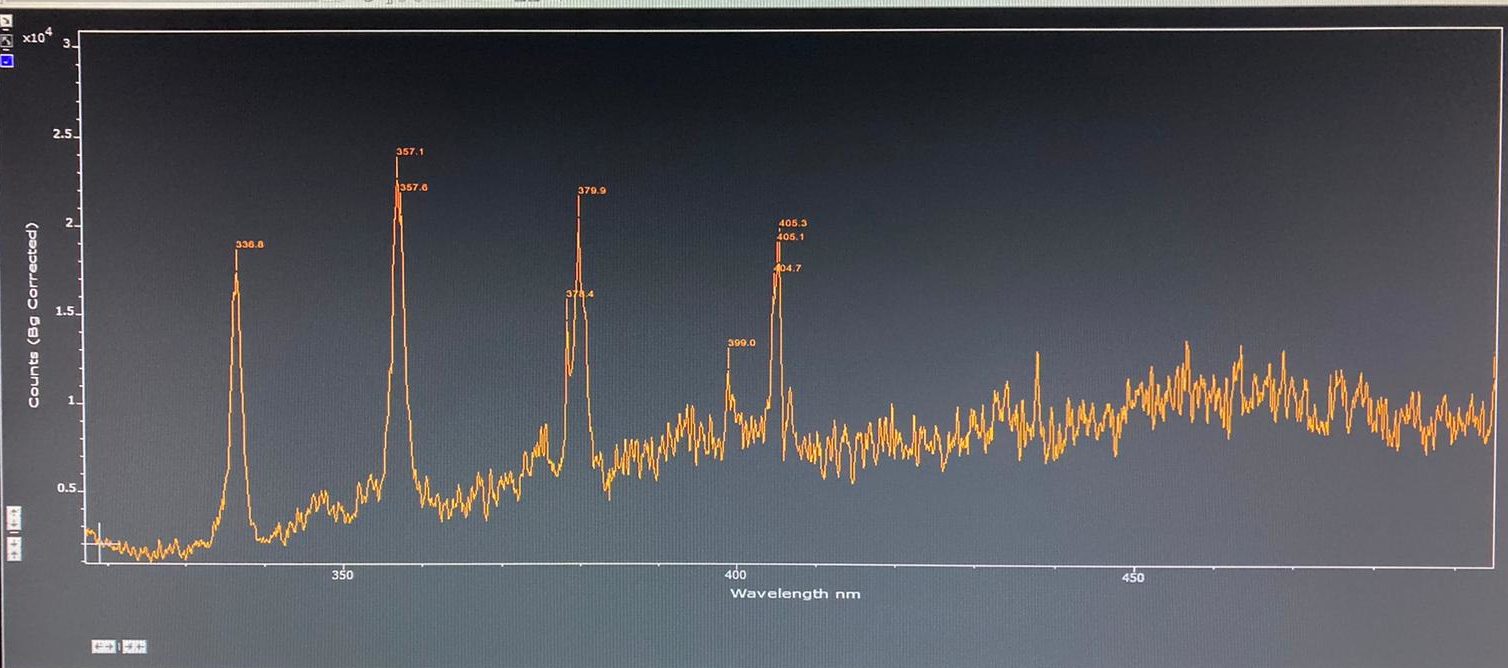 Dr. Mikhail Shneider was looking for an alternative answer to this question: can plasma generated at air-liquid interface be used to modify cell biology? His research is focused on osmosis – diffusion of water – in cell environment activated by a non-equilibrium plasma source. He studied ion movements due to electric field in the concept of electro-osmosis and emphasized that hydrated ions with a water shell around become larger in size and slower in mobility. The varying dimensions and time scales can be utilized for the selectivity of cell membrane. The osmotic pressure outside cells can be controlled by plasma and be adjusted to damage cell membrane. Additionally, air or oxygen plasma-treated water becomes acidic and disrupts the outer walls of bacteria and viruses. He specifically underlined that osmotic pressure cannot be the only mechanism destroying cells; however, its role cannot be studied in detail yet.
Dr. Mikhail Shneider was looking for an alternative answer to this question: can plasma generated at air-liquid interface be used to modify cell biology? His research is focused on osmosis – diffusion of water – in cell environment activated by a non-equilibrium plasma source. He studied ion movements due to electric field in the concept of electro-osmosis and emphasized that hydrated ions with a water shell around become larger in size and slower in mobility. The varying dimensions and time scales can be utilized for the selectivity of cell membrane. The osmotic pressure outside cells can be controlled by plasma and be adjusted to damage cell membrane. Additionally, air or oxygen plasma-treated water becomes acidic and disrupts the outer walls of bacteria and viruses. He specifically underlined that osmotic pressure cannot be the only mechanism destroying cells; however, its role cannot be studied in detail yet.
Tag: Plasma Science
Seminar notes: Plasma Design of 2D Nanostructures and Beyond Graphene
Prof. Uroš Cvelbar discussed their work on plasma assisted graphene nanowall growth on plasma treated substrates in changing conditions of pressure and temperature as well as different gas mixtures. His group and collaborators worked on a computational model of large scale production. The model confirmed that lateral surface diffusion through nanoflakes are the main mechanism in catalysis rather than vertical particle transfer because of the ion bombardment causing surface defects and resulting an increase in surface adsorption energy. This was the key takeaway for my future research on understanding of the mechanisms of plasma sintering.
https://mipse.umich.edu/ltp_seminars.php
Notes from Gaseous Electronics Conference (GEC) 2020
Well… Having the whole conference on Zoom was an interesting experience but in fact I like it! There were little to zero technical difficulties and we were able to ask our questions on a chat box. Except for free food, I might prefer online conferences in the future. Because, I took great notes during presentations and while watching the pre-recorded ones! I also attended a very important workshop for myself: Women in Plasma Science. I want to share my notes and opinions on it.
Continue reading “Notes from Gaseous Electronics Conference (GEC) 2020”
Development of a small-scale helical surface dielectric barrier discharge for characterizing plasma-surface interfaces
Understanding plasma-surface interactions is important in a variety of emerging research areas, including sustainable energy, environmental remediation, medicine, and high-value
manufacturing. Plasma-based technologies in these applications utilize surface chemistry driven by species created in the plasma or at a plasma-surface interface. Here, we develop a helical dielectric barrier discharge (DBD) configuration to produce a small-scale plasma that can be implemented in a diffuse reflectance infrared Fourier transform spectroscopy (DRIFTS) cell and integrated with a commercial Fourier transform infrared (FTIR) spectrometer instrument to study plasma interactions with inert or catalytic solid media. The design utilizes the entire surface of a cylinder as its dielectric, enhancing the plasma contact area with a packed bed. In this study, we characterize the electrical and visual properties of the helical DBD design in an empty reaction cell and with added potassium bromide (KBr) powder packing material in both air and argon gas environments at ambient conditions. The new surface DBD configuration was integrated into a DRIFTS cell and the time evolution of water desorbing from the KBr packed bed was investigated. Measurements show that this configuration can be operated in filamentary or glow-like mode depending on the gas composition and the water content absorbed on KBr solid media. These results not only set the basis for the study of plasma-surface interactions using a commercial FTIR, but also show that controlling the gas environment and water content in a packed bed might be useful for studying different plasma regimes that are typically not possible at atmospheric pressure.
You can reach the paper via this link: Nazli Turan et al 2020 J. Phys. D: Appl. Phys
Fifth force?! Wow!
It is happening, and it is happening now. A group of Hungarian researchers showed evidences of a possible-fifth force in the universe! If their results can be reproduced by the others, we know exactly who will get the next Nobel prize!
 This is the website I first read all the details: Physicists Claim They’ve Found Even More Evidence of a New Force of Nature
This is the website I first read all the details: Physicists Claim They’ve Found Even More Evidence of a New Force of Nature
This is a fancy look: A ‘no-brainer Nobel Prize’: Hungarian scientists may have found a fifth force of nature
Plasma meets with Kapton surface
Dielectric barrier discharges are a type of AC plasmas aiming to limit current in time to prevent spark formation. The dielectric layer holds charges, instead of letting them flow as in conductive materials. The constant exposure to plasma species causes wear/deformation on the surface. Here I show an example of Kapton layer.
The impact of transition metal catalysts on macroscopic dielectric barrier discharge (DBD) characteristics in an ammonia synthesis plasma catalysis reactor
When non-equilibrium, low-temperature plasmas and catalysts interact, they can exhibit
synergistic behavior that enhances the chemical activity above what is possible with either process alone. Unlike thermal catalysis, in plasma-assisted catalysis the non-equilibrium state of the plasma produces reactive intermediates, such as excited species, that may play an important role in the catalytic process. There are two primary plasma-surface mechanisms that could produce this synergy: the effect of the plasma on the catalyst (e.g., enhanced adsorption / reaction of plasma activated species, change of surface structure / morphology, hot spots, etc.) and the effect of the catalyst on the plasma state. This work focuses on the latter. We use a laboratory-scale, packed bed, dielectric barrier discharge (DBD) reactor to observe the influence of multiple alumina (Al2O3) supported, transition metal ammonia (NH3) synthesis catalysts on the plasma electrical and optical properties. We find that while the rates of ammonia synthesis over the materials considered, including Fe/Al2O3, Ni/Al2O3, and Co/Al2O3, are different, the macroscopic properties of the DBD are statistically indistinguishable. These results support the argument that the observed synergy in our catalysis experiments is not due to the catalyst modifying the characteristics of the plasma itself, but rather arises from differences in how the plasma environment and plasma-generated species modify chemistry at the catalyst surface, although the specific mechanism is still an outstanding question.
You can reach the paper via this link: , ,
Notes from iPlasmaNano 2018
It was a really dense conference. Mostly, the professors gave talks about the latest updates of their research. The discussions were at high level. I tried to keep my eyes open to follow almost every talk 🙂 But, it’s worth it 🙂 Here are the topics attracting my attention.
Plasma-Enhanced Catalysis: A Detailed Study of Surface Interactions Between Low-Temperature Plasma and Catalytic Materials
Plasma catalysis is an improved conversion of the input gas flow by employing plasma and catalytic process. The applied electric field turns the gas into a conductor indicating the formation of plasma state with free electrons, excited molecules, and ions. The resulting low temperature, non-equilibrium plasma with energetic electrons interacts with the catalytic surface. Plasma-catalyst combination has a surplus effect, called synergy. Due to the synergistic effects of plasma catalysis, it has many applications including the destruction of volatile organic compounds, the production of fertilizers, the synthesis of value-added chemicals and the conversion of greenhouse gases. Many studies in the literature have presented an outstanding enhancement in the process of conversion. However, due to the multifaceted interaction between plasma and catalyst, the understanding of the fundamental mechanism is missing. In this study, we will focus on basic molecular interactions (e.g., adsorption, desorption) at the plasma-catalyst interface. The key outcome of this research will be the development of a novel reaction chamber in FTIR to investigate the interactions at the molecular level. The in situ FTIR studies will show how plasma species cooperate with catalyst and how those mechanisms are implemented to produce the desired products.
Stabilizing fusion plasmas
“Sawtooth swings—up-and-down ripples found in everything from stock prices on Wall Street to ocean waves—occur periodically in the temperature and density of the plasma that fuels fusion reactions in doughnut-shaped facilities called tokamaks. These swings can sometimes combine with other instabilities in the plasma to produce a perfect storm that halts the reactions. However, some plasmas are free of sawtooth gyrations thanks to a mechanism that has long puzzled physicists.”


Recent Comments